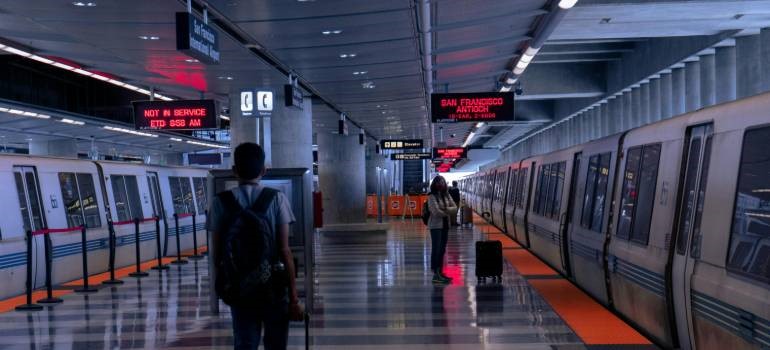Relocating to the East Bay involves many decisions about housing, costs, and lifestyle. The area combines urban centers with quieter suburban communities. Each location offers different price points, commute patterns, and community features. This variety creates unique situations for anyone planning a move. Housing markets can be competitive, and living costs are higher than in many other regions. Commuting times and transportation options vary depending on where you live. Local rules, school systems, and safety levels also differ. Many people start their research by looking for trusted movers in East Bay who understand the region’s layout and challenges. Understanding these differences before you arrive helps you prepare for challenges of moving to East Bay. It also ensures you can make informed choices about where to live.
Navigating the local housing market
Housing prices in the East Bay are among the highest in California. Median home values range from about $750,000 in more affordable areas to $1.35 million in the most expensive neighborhoods. Rental prices vary from $2,300 to over $3,200 per month depending on location and amenities. Competition for homes is strong, with vacancy rates often under 5%. Many landlords require first month’s rent plus a security deposit equal to one month’s rent.

Property taxes follow California’s base rate of 1% plus local assessments, which can raise the total bill. Homes and apartments near BART stations or ferry routes often have higher rents. In Hayward, this stands out in the housing market, as demand often spikes near key commuter routes and BART access. Because of this, moving companies in Hayward CA see steady demand, especially during peak seasons. More affordable options include shared housing, accessory dwelling units, or cooperative living arrangements. Choosing neighborhoods with good commuter access and lower rents can reduce your overall housing expenses significantly.
Comparing East Bay neighborhoods for families and commuters
Neighborhoods in the East Bay vary widely in convenience, amenities, and livability for families and commuters.
- Rockridge in Oakland offers direct BART access and a commute to downtown San Francisco in under 25 minutes, along with highly rated elementary schools and family-friendly cafes.
- Walnut Creek and Lafayette attract commuters to San Francisco and Silicon Valley with their combination of freeway access and top-ranked schools.
- In Castro Valley, commute times to downtown Oakland average 20 minutes, and many homes are close to parks like Lake Chabot Regional Park.
- For safety, areas such as Albany and Piedmont consistently report violent crime rates well below the Alameda County average.
- Families often choose El Cerrito for its combination of moderate home prices and direct BART access.
- For those prioritizing budget, Richmond Annex offers lower housing costs while maintaining convenient access to El Cerrito Plaza BART.
Urban neighborhoods provide walkable access to shops and dining, while suburban zones deliver larger lots and quieter streets, often with more recreational space.

Affordable housing strategies in the East Bay
Housing costs in the East Bay can be reduced with targeted strategies and location flexibility.
- Roommate matching services such as Roommates.com or local Facebook housing groups can lower monthly rent by 30–50%.
- Housing cooperatives, like those in Berkeley and Oakland, often operate with shared ownership and maintenance duties, offering rates around 20% below market.
- City-administered programs, such as Alameda County’s Below Market Rate (BMR) housing, provide capped rents for qualifying households; income thresholds for eligibility can range from $70,000 to $120,000 depending on household size.
- Neighborhoods with older rental stock, such as parts of San Pablo or East Richmond Heights, frequently have rents 10–20% below the regional median while still offering nearby transit and shopping.
Planning a move between October and February—traditionally the slowest rental months—can increase negotiating power, with some landlords offering one month free rent on 12-month leases. Flexibility in location, property type, and lease terms greatly improves the odds of securing a budget-friendly home.
Dealing with traffic and commuting concerns
Traffic congestion is a daily issue for many East Bay residents. Peak-hour car commutes to San Francisco can reach 60 to 75 minutes. Major bottlenecks occur along I-880, I-580, and I-680, especially near the Maze Interchange. Public transportation offers alternatives.
BART connects much of the East Bay to San Francisco and other parts of the Bay Area. Fares average about $4.72 per ride, with longer trips costing $5 to $7 each way. The system runs until around midnight, but schedules may vary by line. The SF Bay Ferry offers a 25-minute ride to San Francisco for about $6.90 one-way.

In Fremont, commute times can be challenging for those traveling to Silicon Valley or San Francisco, particularly during rush hour. Because of this, Fremont moving company teams often help clients plan moves during off-peak hours to avoid traffic delays. AC Transit buses fill gaps where BART is not available. Park-and-ride facilities and regional bike trails make last-mile commuting easier. Planning your travel times around peak congestion helps save time. Understanding your commuting options before choosing a neighborhood will help you balance travel costs and time.
Financial challenges of moving to East Bay
Moving costs in the East Bay can be high compared to other regions. Local household movers typically have higher rates during summer or weekends. Many offer packing services that can save time, though this will add to total costs.
- Gasoline prices average around $4.49 per gallon in California.
- Monthly utilities for a two-bedroom home average between $160 and $210, based on PG&E’s rate of about $0.45 per kilowatt hour.
- Grocery costs are about 20% higher than the national average.
- Eating out also adds up, with lunch at a mid-priced restaurant costing $15 to $20 and dinner ranging from $25 to $40 per person.
- Car insurance premiums vary significantly between ZIP codes.
- Typical renters’ insurance premiums range from $15 to $25 per month.
Combining rent, childcare, and utilities into a single budget figure helps you track affordability.
Preparing for lifestyle adjustments
Life in the East Bay can differ depending on location. Housing costs tend to be higher near the coast compared to inland communities. Air quality issues are more common inland during wildfire season. Urban areas often have more nightlife and entertainment options, while suburban locations may offer more space and quieter streets. Farmers markets are popular, with average spending of $20 to $25 per visit.

Recreational activities include visits to lakes, regional parks, and waterfront trails. The region’s diversity is reflected in a wide range of dining and shopping options. Employment opportunities vary by area, with tech hubs, port jobs, and nonprofit work concentrated in different locations. Balancing these factors will help you choose a neighborhood that matches your priorities and lifestyle.
Adapting to the local climate and environment
The East Bay’s climate varies between coastal and inland areas.
- Coastal neighborhoods average summer highs around 70°F, while inland areas can reach the mid-80s.
- Annual rainfall is about 24 inches, with most rain falling in winter.
- Fog often appears along the shoreline during summer mornings, reducing visibility.
The Hayward Fault runs through several East Bay communities and last produced a major earthquake in 1868 with a magnitude of 6.8. Retrofitting older homes is an important part of earthquake preparedness in the Bay Area and can cost between $4,000 and $7,000. Earthquake insurance availability and premiums vary by location and building type. Wildfire smoke can affect air quality in late summer and fall, sometimes pushing AQI levels above 150.
In Hayward, these environmental risks highlight the value of keeping important belongings safe during emergencies. Many residents choose storage units in Hayward CA to secure seasonal items, furniture, or valuables when conditions are unpredictable. Residents should be prepared for short-term changes in outdoor activity during these periods.
The cultural challenges of moving to East Bay
The East Bay is one of the most culturally diverse areas in California, with Oakland serving as one of its most active cultural hubs. Annual events like Oakland First Fridays, the Art + Soul Festival, and the Eat Real Festival draw thousands of visitors and showcase local food, music, and art. These gatherings give residents opportunities to connect with neighbors, support local businesses, and celebrate community traditions. Median household incomes vary widely across the region, influencing the range of amenities and services available in different neighborhoods.

Nightlife and activity levels differ as well. For example, downtown Oakland offers a lively bar and restaurant scene, while some residential districts remain quiet after dark. Community centers often host fitness classes, language lessons, and youth programs. Many neighborhoods provide multilingual services, making it easier for newcomers to adapt. Movers in Oakland CA regularly assist clients relocating to these vibrant cultural areas, ensuring smooth transitions into diverse and engaging communities. Newcomer support programs also help with language learning, job placement, and building local connections.
Understanding city-specific rules and regulations
Local regulations can affect your daily life after moving to the East Bay. Some cities limit annual rent increases to a fixed percentage or link them to inflation. Others have rent review programs that require mediation for increases over a certain amount. Residential parking permit fees range from about $40 to $66 per year. Moving truck obstruction permits average $35 to $50 per day and often require posting notices several days in advance.
Street sweeping fines are generally between $80 and $100 for violations. Trash and recycling services typically cost between $45 and $55 per month, depending on location. In Alameda, residential neighborhoods have a strict parking permit system in certain zones near the ferry terminal and busy commercial areas. This means planning a move here often requires securing permits in advance to avoid citations. Movers in Alameda CA frequently coordinate with clients to obtain the correct permits and schedule moves during off-peak times to comply with city regulations. Zoning rules may affect how you can use your home, especially if you plan to operate a business or rent out part of the property. Understanding these regulations before moving helps avoid unexpected fees and compliance issues.
Finding suitable schools and childcare options
School quality in the East Bay varies by district and neighborhood. Graduation rates in top-performing districts often exceed 90%. Some districts rank among the highest in California based on state dashboard ratings. Other areas have mixed performance, and some charter schools maintain long waitlists. Monthly daycare costs range from about $1,400 to $1,800, depending on age group and facility type.

Public school enrollment deadlines can be 8 to 10 months before the school year starts, which requires careful timing for relocating families. After-school programs differ by district, with some offering more extracurricular activities and extended care options. In San Leandro, families benefit from a mix of neighborhood elementary schools, a comprehensive high school, and specialized magnet programs. The district also offers bilingual education and career-focused academies. Movers in San Leandro CA often work with parents who plan their relocation around school registration periods to secure spots in preferred programs. Reviewing both school ratings and available offerings can help you choose a location that supports your children’s education.
Staying safe and secure in urban areas
Safety levels vary across East Bay neighborhoods. Violent and property crime rates in California can differ significantly between areas only a few miles apart. Some neighborhoods consistently report lower crime rates than the regional average. Package theft and vehicle break-ins are among the most common property crimes. Many residents choose to install security systems, which cost between $25 and $40 per month for monitoring.
Taking basic precautions, such as locking vehicles and securing deliveries, can reduce risks. Reviewing neighborhood crime trends helps set realistic expectations and identify safer places to live. In some areas, community watch programs and neighborhood associations play an active role in maintaining safety. Understanding local safety patterns is an important part of choosing a home in the East Bay.
Making the move work for you
Preparing for relocation is essential to handle the challenges of moving to East Bay successfully. Understanding local housing markets, transportation options, and environmental conditions helps you make informed decisions. Being aware of community differences, regulations, and school quality ensures you find the right fit for your needs. Safety considerations, lifestyle preferences, and overall costs should all be factored into your plans. Taking the time to review these aspects before moving will reduce surprises and make the transition easier. Each part of the East Bay offers unique advantages, but choosing well means balancing your priorities with available options. With accurate information and thoughtful preparation, you can enjoy your new home and take full advantage of what the region offers.
Tags
Subscribe to Upline Moving's Blog










